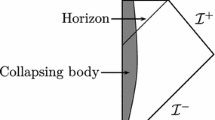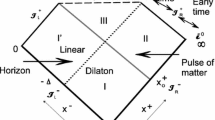Abstract
We display a number of advantages of objective collapse theories for the resolution of long-standing problems in cosmology and quantum gravity. In particular, we examine applications of objective reduction models to three important issues: the origin of the seeds of cosmic structure, the problem of time in quantum gravity and the information loss paradox; we show how reduction models contain the necessary tools to provide solutions for these issues. We wrap up with an adventurous proposal, which relates the spontaneous collapse events of objective collapse models to microscopic virtual black holes.



Similar content being viewed by others
Notes
Before moving on we would like to say something about the interpretation of objective collapse theories. As we mentioned before, the main motivation for the construction of these theories is to avoid the measurement problem. That is, to construct a theory without the standard probabilistic interpretation of the quantum state. However, if one removes the standard probabilistic interpretation, without substituting it by something else, one loses the ability to make predictions and to get in touch with the physical world (see [15, 16]). Therefore, objective collapse models require a new interpretation. One could think of interpreting the wave-function directly as physical, as Schrödinger initially intended. However, the fact that wave-functions of multi-particle systems live in configuration space is something that renders this option unattractive to many. An alternative, first presented in [17], is to interpret the theory as describing a physical field \(m(\mathbf {x},t)\), constructed as the expectation value of the mass density operator on the state characterizing the system (the relativistic version of this interpretation is discussed in [18]). Yet another option, proposed in [19] and used in [8], is to take the GRW collapses, which occur at precise space–time points, as the quantities on which physical descriptions should be based.
These are usually taken to be the Bunch Davies vacuum, which is a state of the quantum field naturally associated with the early de Sitter phase of the accelerated expansion.
Such statistical aspects include considerations about: i) an hypothetical ensemble of universes, ii) different space and time regions of our universe and (iii) distinct orientations of our observations and characterizations of the CMB. Issues regarding the assumed connection between the quantum and statistical aspects of our characterization of the objects of interest also need to be considered.
In order to solve this problem within the standard account, one would need to hold that to allow the identifications described above it is necessary to invoke a further averaging over orientations, without which predictions are not reliable. The problem is that there is no justification whatsoever for this assumption.
In the sense that only after the stochastic variables have been converted into quantities with definite numerical values would those operators become explicitly defined.
There is a view according to which one need not worry about information loss and unitarity breakdown simply because \(\mathcal{I }^+\), or space-like hypersurfaces approaching it, are no Cauchy hypersurfaces. If that is the case, the singularity (or a space-like hypersurfaces near it) represents an additional part of the boundary of space–time where the causal curves can end. This is, from the purely mathematical point of view, complete accurate and correct. However, the issue is how are the observers that witness the complete evaporation, of say, a very small black hole, to characterize what they see as their space–time in which the black hole has disappeared? What would they say regarding the evolution of the physical objects that for them represent the totality of what exist at a certain region they consider to be a Cauchy hypersurface? That means that at the effective level, that of the laws of physics as they observe them to hold, they must confront a problem: are the laws of evolution compatible with quantum unitarity or are they not?
Quantum field theory is usually considered the essential language in which to handle quantum matter in a spacial relativistic context. In the regime where gravity becomes important, we also envision a quantum field theoretic treatment of matter fields but at the very fundamental level we envision some sort of quantum gravity theory, perhaps resembling some of the currently popular programs, but modified to include effects that at the more effective level look like dynamical reductions.
As far as we are aware, Penrose was the first to argue for collapse to resolve the black hole information paradox.
A study of a range of possibilities for a stochastic fundamental law of evolution is presented in [47]
We would like to thank an anonymous referee for leading us to explore this issue in some detail.
References
Perez, A., Sahlmann, H., Sudarsky, D.: On the quantum origin of the seeds of cosmic structure. Class. Quantum Gravity 23, 2317 (2006)
Bohm, D., Bub, J.: A proposed solution of the measurement problem in quantum mechanics by a hidden variable theory. Rev. Mod. Phys. 38, 453 (1966)
Pearle, P.: Reduction of the state vector by a nonlinear Schrödinger equation. Phys. Rev. D 13, 857 (1976)
Pearle, P.: Towards explaining why events occur. Int. J. Theor. Phys. 18, 489 (1979)
Ghirardi, G., Rimini, A., Weber, T.: A model for a unified quantum description of macroscopic and microscopic systems. In: Accardi, A.L. (ed.) Quantum Probability and Applications, pp. 223–232. Springer, Heidelberg (1985)
Ghirardi, G., Rimini, A., Weber, T.: Unified dynamics for microscopic and macroscopic systems. Phys. Rev. D 34, 470 (1986)
Bassi, A., Lochan, K., Satin, S., Singh, T., Ulbricht, H.: Models of wave-function collapse, underlying theories, and experimental tests. Rev. Mod. Phys. 85, 471 (2013)
Tumulka, R.: A relativistic version of the Ghirardi–Rimini–Weber model. J. Stat. Phys. 125, 821 (2006)
Bedingham, D.: Relativistic state reduction model. J. Phys. Conf. Ser. 306, 012034 (2011)
Tumulka, R.: On spontaneous wave function collapse and quantum field theory. Proc. R. Soc. A 462, 1897 (2006)
Pearle, P.: Combining stochastic dynamical state-vector reduction with spontaneous localization. Phys. Rev. A 39, 2277–2289 (1989)
Ghirardi, G., Pearle, P., Rimini, A.: Markov-processes in Hilbert-space and continuous spontaneous localization of systems of identical particles. Phys. Rev. A 42, 78–89 (1990)
Pearle, P.: Toward a relativistic theory of statevector reduction. In: Miller, A. (ed.) Sixty-Two Years of Uncertainty, pp. 193–214. Plenum, New York (1990)
Ghirardi, G., Grassi, R., Pearle, P.: Relativistic dynamical reduction models: General framework and examples. Found. Phys., J.S. Bell’s 60th birthday issue 20, 1271 (1990).
Albert, D.: In: Clifton, R. (ed.) Perspectives on Quantum Reality: Non-relativistic, Relativistic, Field-Theoretic, pp. 81–92. Kluwer, Dordrecht (1996)
Lewis, P.J., Stud: Interpreting spontaneous collapse theories. His. Phil. Mod. Phys. 36, 165–180 (2005)
Ghirardi, G., Grassi, R., Benatti, F.: Describing the macroscopic world: closing the circle within the dynamical reduction program. Found. Phys. 35, 5 (1995)
Bedingham, D., Dürr, D., Ghirardi, G., Goldstein, S., Tumulka, R., Zanghì, N.: Matter density and relativistic models of wave function collapse. J. Stat. Phys. (2013), arXiv:1111.1425.
Bell, J.S.: Are there quantum jumps? In: Kilminster, C.W. (ed.) Schrödinger: Centenary Celebration of a Polymath, pp. 109–123. Cambridge University Press, Cambridge (1987)
García, G.L., Landau, S.J., Sudarsky, D.: Quantum origin of the primordial fluctuation spectrum and its statistics. Phys. Rev. D 88, 023526 (2013)
Padmanabhan, T.: Structure Formation in the Universe. Cambridge University Press, Cambridge (1993)
Weinberg, S.: Cosmology. Oxford University Press, Oxford (2008)
Mukhanov, V.: Physical Foundations of Cosmology. Cambridge University Press, Cambridge (2005)
Sudarsky, D.: Shortcomings in the understanding of why cosmological perturbations look classical. Int. J. Mod. Phys. D 20, 509 (2011)
Diez-Tejedor, A., Sudarsky, D.: Towards a formal description of the collapse approach to the inflationary origin of the seeds of cosmic structure. JCAP 07, 045 (2012)
Unanue, A.D., Sudarsky, D.: Phenomenological analysis of quantum collapse as source of the seeds of cosmic structure. Phys. Rev. D 78, 043510 (2008)
Landau, S.J., Scoccola, C.G., Sudarsky, D.: Cosmological constraints on nonstandard inflationary quantum collapse models. Phys. Rev. D 85, 123001 (2012)
Martin, J., Vennin, V., Peter, P.: Cosmological inflation and the quantum measurement problem. arXiv:1207.2086 [hep-th] (2012).
Cañate, P., Pearle, P., Sudarsky, D.: Continuous spontaneous localization wave function collapse model as a mechanism for the emergence of cosmological asymmetries in inflation. Phys. Rev. D 87, 104024 (2013)
Das, S., Lochan, K., Sahu, S., Singh, T.P.: Quantum to classical transition of inflationary perturbations: continuous spontaneous localization as a possible mechanism. Phys. Rev. D 87, 085020 (2013)
Isham, C.J.: Canonical quantum gravity and the problem of time. gr-qc/9210011 (1992).
Gambini, R., Porto, R.A., Pullin, J.: Realistic clocks, universal decoherence and the black hole information paradox. Phys. Rev. Lett. 93, 240401 (2004)
Gambini, R., Porto, R.A., Pullin, J.: Fundamental decoherence from relational time in discrete quantum gravity: Galilean covariance. Phys. Rev. D 70, 124001 (2004)
Hawking, S.: Particle creation by black holes. Commun. Math. Phys. 43, 199 (1975)
Almheiri, A., Marolf, D., Polchinski, J., Sully, J.: Black holes: complementarity or firewalls? (2012) arXiv:1207.3123 .
Braunstein, S. L.: Black hole entropy as entropy of entanglement or it’s curtains for the equivalence principle (2009) arXiv:0907.1190v1 [quant-ph].
Braunstein, S.L., Pirandola, S., Zyczkowski, K.: Better late than never: information retrieval from black holes. Phys. Rev. Lett. 110, 101301 (2013)
Ashtekar, A., Bojowald, M.: Black hole evaporation: a paradigm. Class. Quantum Gravity 22, 3349 (2005)
Pearle, P., Squires, E.: Bound-state excitation, nucleaon decay experiments, and models of wave-function collapse. Phys. Rev. Lett. 73, 1 (1994)
Penrose, R.: The Road to Reality. Knopf, New York (2004)
Penrose, R.: Time asymmetry and quantum gravity. In: Isham, C.J., Penrose, R., Sciama, D.W. (eds.) Quantum Gravity II, p. 244 (1981)
Hawking, S.: Quantum black holes. In: Hawking, S., Penrose, R. (eds.) The Nature of Space and Time, pp. 37–60. Princeton University Press, Princeton (2000)
Callender, C.: Is time an illusion? Sci. Am. 302(3), 1–11 (2010)
Callender, C.: Shedding light on time. Philos. Sci. (Proc.) 67, S587 (2000)
Callender, C. (ed.): Time, Reality and Experience. Time, Reality and Experience. Cambridge University Press, Cambridge (2002)
Smolin, L.: The Life of the Cosmos. Oxford University Press, Oxford (1997)
Bassi, A., Durr, D., Hinrichs, G.: Uniqueness of the equation for quantum state vector collapse. Phys. Rev. Lett. 111, 210401 (2013)
Colin, S., Valentini, A.: Mechanism for the suppression of quantum noise at large scales on expanding space (2013). arXiv:1306.1579 [hep-th].
Valentini, A.: Inflationary cosmology as a probe of primordial quantum mechanics. Phys. Rev. D 82, 063513 (2010)
Valentini, A.: Hidden variables and the large-scale structure of spacetime. In: Craig, W.L., Smith, Q. (eds.) Einstein, Relativity and Absolute Simultaneity, pp. 125–155. Routledge, London (2005)
Pinto-Neto, N., Fabris, J.C.: Quantum cosmology from the de Broglie–Bohm perspective. Class. Quantum Gravity 30, 143001 (2013)
Pinto-Neto, N., Santos, G., Struyve, W.: Quantum-to-classical transition of primordial cosmological perturbations in de Broglie–Bohm quantum theory. Phys. Rev. D 85, 083506 (2012)
Falciano, F., Pinto-Neto, N.: Scalar perturbations in scalar field quantum cosmology. Phys. Rev. D 79, 023507 (2009)
Goldstein, S., Teufel, S.: Quantum spacetime without observers: ontological clarity and the conceptual foundations of quantum gravity. Physics Meets Philosophy at the Planck Scale, pp. 275–289. Cambridge University Press, Cambridge (2001)
Acknowledgments
We would like to acknowledge partial financial support from DGAPA—UNAM projects IN107412 (DS), IA400312 (EO), and CONACyT project 101712 (DS).
Author information
Authors and Affiliations
Corresponding author
Rights and permissions
About this article
Cite this article
Okon, E., Sudarsky, D. Benefits of Objective Collapse Models for Cosmology and Quantum Gravity. Found Phys 44, 114–143 (2014). https://doi.org/10.1007/s10701-014-9772-6
Received:
Accepted:
Published:
Issue Date:
DOI: https://doi.org/10.1007/s10701-014-9772-6




